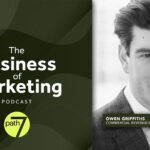By Alex Kintzer, Senior Data Analyst & Global Researcher, Songtradr
Music is vital when it comes to advertising and branding—consider the alternative… A world of silent commercials? Ads that end without a hummable, memory-aiding jingle? Conscious or not, music is what makes commercials sing!
So why doesn’t every marketing conversation start with music, as opposed to shoehorning it in at the last minute? The business world likes neatness and justification. After all, it’s much cleaner when everything you embark upon—from a marketing or sales standpoint—makes solid sense from the get-go. But that’s not (typically) how you create lasting, bold, work.
Here’s what we mean: Rory Sutherland, Vice Chairman of Ogilvy UK, suggested that “once you make winning an argument in advance a requirement of anything you do, it limits the solution space by 95%.” In other words, pre-setting parameters creates limitations.
In a world filled with rules, structures, deadlines and targets, music emerges as the last holdout—the unchained rebel, the wily younger sibling. This unique position historically has also been the nail in music’s coffin. As creative as music is, it’s also deeply subjective. It rarely resonates equally with everyone, meaning it’s sometimes relegated to the realm of afterthought. This may be why music makes up only 4% of typical marketing budgets. Fortunately, evidence shows it can boost advertising performance by as much as 30%. So again, why aren’t people consistently putting thought into it earlier in the process?
As with every creative field, the world doesn’t always know how to value such creativity; people love music, but without a way to measure it (aka justify it as an investment), it creates room for debate and becomes a point of argument. Everyone has a story about how a certain song brings them back to a moment in time. But for each individual person, that special song is different. Giving up valuable airtime in a 30-second ad for musical notes may be a tough decision if everything is based on vibes or one’s personal preferences alone.
But thanks to rapid technological advances, including AI analysis, alongside the application of sophisticated testing, music data can not only convince the skeptics but actually lead to braver, more distinctive, and ultimately more effective (and affective) creative. As IPSOS reminds us, only 8% of ads contain distinctive branded music, even though advertising that includes audio appropriate to the brand being advertised performs eight times better.
So what does leveraging data to get the perfect track look like?
Take Nissan’s Lofi Girl video, for instance. This campaign provides real-world results of using music data to target specific demographics. Having viewed data showing that people attracted to lofi music were more likely to be interested in electric vehicles, Nissan developed a campaign that targeted that demographic by their listening habits on YouTube and resulted in a 75% lift in people searching for the new all-electric Nissan Ariya. As Aoife McGuinness of CloudArmy pointed out, “You know it’s the right creative when you get a gut feeling—with neurobiological/implicit testing, we’re just quantifying that gut feeling.”
Need more proof? TikTok’s new sonic identity is “the fastest recognizable [sonic] brand ever”, with demographic attribution by Gen Z at almost 50% just 5 months after launch.
What’s more, academic research has recently shown that the presence of a sonic logo can create a positive brand experience, even in the face of “uncertain and anxiety-inducing decision context or negative information about the target brand”—what brand wouldn’t want that safety net?
Given limited marketing budgets, it can be easy to push music to the last step or skip it altogether—it’s seemingly neater and more justifiable that way. But bold brands make brave choices, and research and data give you the opportunity to not only bring music into the conversation immediately, but to generate memories that last well beyond the campaign lifecycle.






